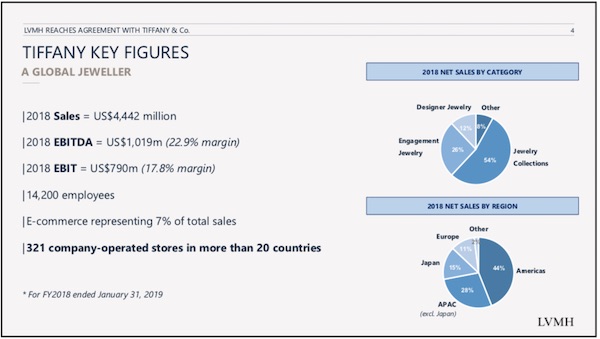Articles and News
Industry News: LVMH Buys Tiffany; Two Studies Address Holiday Gifting; Dresden Jewelry Heist November 26, 2019 (0 comments)

Industry News: LVMH Buys Tiffany; Two Studies Address Holiday Gifting; Dresden Theft
New York, NY—It’s official: Tiffany & Co. (NYSE: TIF) will become part of French-based luxury conglomerate LVMH, it was announced Monday. The deal, which will close at $130 per share, or $16.2 billion, will give LVMH a better foothold in the American luxury market and add to its stable of jewelry and watch brands, which currently include Bvlgari, Hublot, Chaumet, Fred, and TAG Heuer.
The American luxury jeweler initially rejected an unsolicited bid of $120 per share—$14.5 billion—from the luxury conglomerate last month, but its language did not eschew the idea of a merger: it merely rejected the valuation and asked LVMH to come up with a better offer. It did, sweetening the pot by $15 per share. The transaction is subject to the approval of Tiffany’s shareholders and clearance by relevant regulatory authorities, but it is expected to go through by mid 2020.
Although the retailer has been struggling with sales and product challenges in the past few years, LVMH CEO Bernard Arnault recognized its “unparalleled heritage and unique position in the global jewelry world” in a release.
Related: Tiffany, Sterling Turnarounds Are Progressing Well, Say CEOs
Indeed, Flavio Cereda, an equity analyst at Jeffries, said in a note that Tiffany’s “brand equity and the strength of the image of its iconic 1837 Blue Box are more valuable than the current financials suggest,” and a report from global consulting company Bain & Co. said jewelry grew 7% last year, one of the top growth luxury categories, although obviously Tiffany wasn’t one of the top beneficiaries of that growth.
The Tiffany brand, which was founded by namesake Charles Lewis Tiffany in lower Manhattan in 1837, now boasts more than 300 stores worldwide. LVMH is eyeing the Asian Millennial market as a growth area for Tiffany, which would likely involve rethinking its product and its American footprint, said Cereda. Indeed, many of the company’s current sales woes are the direct result of the decision to kill its own golden goose: its sterling silver jewelry, which, with its attainable price tags, accounted for 30%of the brand’s U.S. sales. In 2003, Tiffany jacked up silver jewelry prices by 400%, ending that category’s popularity with a bang. Since then, it’s had somewhat of a revolving door of both executives and product introductions, some of which were moderately successful but none of which replaced the sales power of the iconic “Return To Tiffany” and the other silver collections.

Related: Tiffany Sales Drop On Weak Tourism
But LVMH sees Tiffany’s “wide range of prices as a good way to attract younger shoppers,” which suggests a revitalization of its lower-priced categories. The jeweler also is a category leader in sustainability and ethical sourcing, a very important aspect for younger consumers.

Tiffany’s current CEO Alessandro Bogliolo, a speaker at last week’s Bloomberg’s The Year Ahead Luxury conference, was slated to discuss legacy luxury brands’ role in the future. Instead, he spent most of his session deftly sidestepping relentless questions about the merger from Carol Massar, co-anchor of Bloomberg Businessweek. One of Massar’s questions was whether the additional resources resulting from an LVMH merger would help him focus more on brand-building than satisfying Wall Street. In Monday’s announcement, Bogliolo indeed did note that the company has been striving for “sustainable, long-term growth” and said the acquisition will “provide further support, resources and momentum for those priorities as we evolve toward becoming the next generation luxury jeweler.”

Vertical integreation and sustainability is a key selling point for Tiffany.
Read more here, here, here, here, and here. All charts: LVMH presentation to investors
Studies: Mass Affluent To Carry Holiday; “Authentic” Gifts Mean The Most To Recipients
New York, NY—The 2019 Deloitte Holiday Retail Survey of 4,000 U.S. consumers has predicted a rosy 4.5% to 5% spike in holiday sales this season, even higher than the National Retail Federation’s optimistic predictions of gains around 4%.
But it comes with some caveats that are both good and not-so-good news for jewelers. The good news is that the mass affluent will drive more than 60% of the spending. These consumers, who earn between $100,000 and $249,000 are dubbed HENRY, or High Earner Not Rich Yet, by market researcher Pamela Danziger.
Since these are a heavy percentage of better jewelers’ customer base, that is good news. On average, these consumers plan to spend about $2,555 each.
But enter a note of caution: jewelry was not listed on the survey’s “pick list” of gifts they plan to give. A big portion of their spending will go towards travel and entertainment, and for actual gifting—to others or self—on their lists are clothing, food/spirits, books, gift cards, beauty/personal care, games, shoes, and home furnishings.
In a commentary on the findings, Danziger also observed that the truncated holiday season is going to be tougher for brick-and-mortar stores serving this demographic, because higher-income shoppers are driven by convenience. While 69% of them still will ultimately buy in-store after researching online, both she and Deloitte predict online will be the biggest winner this season, with a growth rate between 14% and 18%.
Separately, new research from a study by Yale University professor and psychologist Dr. George E. Newman shows that shows that authenticity is central to the value of a gift for recipients
The study, Consumer Preference for Authenticity and Naturalness, released last week, examines the psychology behind which holiday gifts mean the most and why. It echoes previous studies where neuroscientists have found that the pleasure people report when viewing authentic works of art is correlated with activation within the brain.
“In today’s online marketplace, people are deluged with more choices than ever before,” said Newman, associate professor of management and marketing at the Yale School of Management. “From natural diamonds to authentic brands such as Apple or North Face, people are drawn to items because of their authenticity.” He goes on to describe that an item can be authentic in multiple ways:
- Materials: A cashmere sweater vs. a synthetic replica.
- Origin: A Louis Vuitton handbag manufactured in the company’s original workshop in Paris is valued as more authentic than an identical bag manufactured in the company’s California workshop.
- History: A painting that was physically created by Pablo Picasso is worth millions of dollars, while a replica never touched by Picasso is virtually worthless.
- Naturalness: Natural diamonds formed by the earth three billion years ago are valued as more authentic than synthetic replicas created in factories for commercial purposes.
Other key findings from the study:
- Authenticity is appreciated by all ages: This was true for consumers, grouped by ages that spanned from 18-80.
- Consumers most appreciated specific authentic items: Of the eight categories studied, the top gifts consumers appreciated were an authentic branded product (such as a North Face jacket, by 93%, or an Apple Watch, by 86%; a natural diamond ring, by 86%; or a product made with authentic quality materials, such as a cashmere sweater, cited by 88%.
- Inauthentic products are disappointing, said respondents. Some of the items people were most disappointed in receiving included lab-grown diamonds (31%) and knockoff shoes (36%). Indeed, the study found people would rather receive something else entirely, instead of a knockoff or fake.In place of a cashmere sweater, people would rather receive a wool sweater than a sweater with synthetic composition mimicking cashmere.
“Objects can radiate authenticity in many ways, from the natural materials or traditional craftsmanship that compose an item, to the origin of the item’s production or heritage of its brand story.” said Kristina Buckley Kayel, managing director of the Diamond Producers Association North America. “The common theme found throughout authentic products, however, is their capacity to bestow emotional and sentimental value, whether purchased for one’s self or as a gift for a loved one.”
One additional finding highlighted that for identical authentic items, the origin or the history of the item’s story significantly influenced preference. When evaluating the importance of qualities such as rarity, origin and value over time, natural diamonds patterned closer to one-of-a-kind authentic items such as a Babe Ruth autographed baseball, than they did to luxury items in general. Meanwhile, lab-grown diamonds patterned closer to cubic zirconia. The study also found an item can also be valued as authentic because it is produced by a trusted, authentic, sought-after brand.
Royal Jewels Stolen In German Museum Heist
Dresden, Germany—Three priceless sets of 18th-century royal jewelry were stolen Monday from the Green Vault in Dresden, one of the world’s oldest museums and renowned for its jewelry collections. According to the Associated Press, German authorities said thieves with an ax broke one glass case containing three sets of Baroque-era jewelry.
Police were alerted by museum security around 5 a.m. Monday morning Dresden time, but by then the thieves had fled in a getaway car. Although police quickly closed the on-ramps to nearby highways, the close proximity of those roads means the thieves may have already been speeding away.
German investigators suspect a fire at a nearby electrical junction box that took out the streetlights near the museum was connected to the crime.
The pieces, highly recognizable, will be impossible to sell on the open market. Jewelry historians hope the thieves will keep the pieces intact and not break them apart to sell the many gems they contain.







